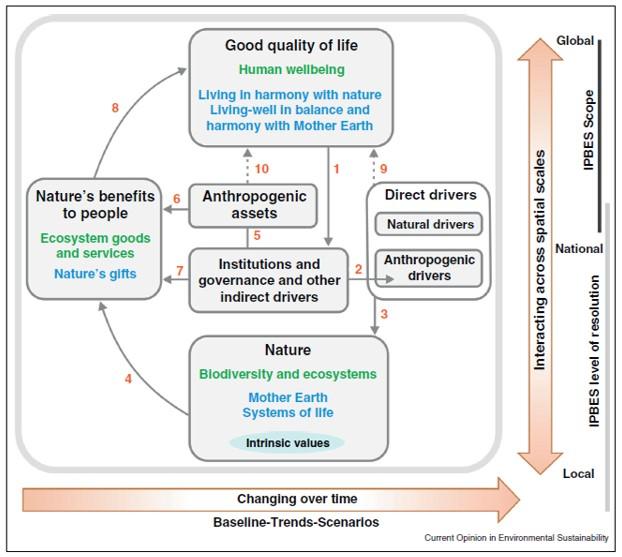Intergovernmental Platform on Biodiversity and Ecosystem Services
IPBES was created in 2012 in Panama by more than 100 governments as a mechanism to provide scientific information in response to requests from decision makers. It is located in the umbrella of four United Nations entities: UNEP, FAO, UNDP and UNESCO, and is managed by UNEP. Its secretariat is located on the UN campus in Bonn, Germany. Currently, the platform has 128 member nations and approximately 1,000 scientists from around the world appointed by their governments or its organizations and selected by the Multidisciplinary Experts Panel (MEP) to contribute voluntarily to the work of IPBES.
FUNCTIONS
IPBES involves scientists and other knowledge holders around the world to analyze and evaluate relevant scientific and technic information produced worldwide to understand biodiversity and ecosystem services. The Platform does not produce new research. The work of IPBES is centered in four complementary essential functions:
CAPACITY BUILDING:
Increase the ability of the scientific policy community to execute and use IPBES assessments and other products;
TO PRODUCE KNOWLEDGE:
Identify the knowledge needs of decision makers and catalyze efforts to produce new knowledge;
EVALUATION:
Deliver global, regional and thematic assessments of knowledge on biodiversity and ecosystem services;
SUPPORT POLICY:
Identify relevant policy tools / methodologies, facilitate its use, and promote and catalyze their future development.

MISSION
The mission of IPBES is to strengthen the interface between science and policy for biodiversity and ecosystem services for the conservation and sustainable use of biodiversity, long-term human well-being and sustainable development.
Operation
The Plenary is the decision-making body of the Platform. It is composed of Government members (of the 128 signatory countries) and observers. The Plenary has appointed two subsidiary bodies: the Bureau and the Multidisciplinary Experts Panel (MEP). The Bureau is responsible for overseeing administrative functions and is composed of 10 members (two from each UN region, including one chair and four vice-chairs). The MEP is responsible for carrying out the scientific and technical functions of the work program. It is composed of 25 members (five from each UN region, including two co-chairs and three vice-chairs). Observers, including Bureau members, chairs of scientific bodies of biodiversity-related multilateral environmental agreements, and the president of IPCC may participate in MEP meetings.
Intergovernmental Platform on Biodiversity and Ecosystem Services
IPBES was created in 2012 in Panama by more than 100 governments as a mechanism to provide scientific information in response to requests from decision makers. It is located in the umbrella of four United Nations entities: UNEP, FAO, UNDP and UNESCO, and is managed by UNEP. Its secretariat is located on the UN campus in Bonn, Germany. Currently, the platform has 128 member nations and approximately 1,000 scientists from around the world appointed by their governments or its organizations and selected by the Multidisciplinary Experts Panel (MEP) to contribute voluntarily to the work of IPBES.
FUNCTIONS
IPBES involves scientists and other knowledge holders around the world to analyze and evaluate relevant scientific and technic information produced worldwide to understand biodiversity and ecosystem services. The Platform does not produce new research. The work of IPBES is centered in four complementary essential functions:
CAPACITY BUILDING:
Increase the ability of the scientific policy community to execute and use IPBES assessments and other products;
TO PRODUCE KNOWLEDGE:
Identify the knowledge needs of decision makers and catalyze efforts to produce new knowledge;
EVALUATION:
Deliver global, regional and thematic assessments of knowledge on biodiversity and ecosystem services;
SUPPORT POLICY:
Identify relevant policy tools / methodologies, facilitate its use, and promote and catalyze their future development.

MISSION
The mission of IPBES is to strengthen the interface between science and policy for biodiversity and ecosystem services for the conservation and sustainable use of biodiversity, long-term human well-being and sustainable development.
Operation
The Plenary is the decision-making body of the Platform. It is composed of Government members (of the 128 signatory countries) and observers. The Plenary has appointed two subsidiary bodies: the Bureau and the Multidisciplinary Expert Panel (MEP). The Bureau is responsible for overseeing administrative functions and is composed of 10 members (two from each UN region, including one chair and four vice-chairs). The MEP is responsible for carrying out the scientific and technical functions of the work program. It is composed of 25 members (five from each UN region, including two co-chairs and three vice-chairs). Observers, including Bureau members, chairs of scientific bodies of biodiversity-related multilateral environmental agreements, and the president of IPCC may participate in MEP meetings.
WORK PROGRAM 2014-2018
IPBES work program for the period 2014-2018 was designed to implement the objectives, functions and principles of operation of the Platform in a coherent and integrated manner. This program comprises a sequential set of objectives, actions, goals and outputs to advance its four functions at relevant scales. The analytical work started under the work program will be guided by the conceptual framework of the platform.
For more details on the evaluation processes, the conceptual framework and the first thematic diagnosis of IPBES, please watch the lectures online clicking here.
WORK PROGRAM 2014-2018
IPBES work program for the period 2014-2018 was designed to implement the objectives, functions and principles of operation of the Platform in a coherent and integrated manner. This program comprises a sequential set of objectives, actions, goals and outputs to advance its four functions at relevant scales. The analytical work started under the work program will be guided by the conceptual framework of the platform.
For more details on the evaluation processes, the conceptual framework and the first thematic diagnosis of IPBES, please watch the lectures online clicking here.
Conceptual Framework of IPBES
On the central panel, delimited in gray, boxes and arrows denote the elements of nature and society that are the main focus of the platform. In each box, the text in black indicates categories that should be intelligible and relevant to all interested parties in IPBES, and cover the categories of Western science (green) and equivalent or similar categories in other systems of knowledge (blue). The blue and green categories are illustrative, not exhaustive, and are best explained in Diaz et al, 2015. The solid arrows on the main panel denote the influence among the elements; the dotted arrows denote links that are recognized as important but are not the primary focus of IPBES. The colored arrows, to the right and bottom of the main panel, indicate that interactions between elements change over time and occur at various spatial scales. The vertical lines at the extreme right of the figure indicate that, although the scope of IPBES inventories is on the supranational-subregional to global scales, they will be partly constructed from relations and properties acting on finer scales.
Adapted from Diaz et al (2015) “The IPBES conceptual framework – connecting nature and people”. Current Opinion in Environmental Sustainability 14: 1-16.

Conceptual Framework of IPBES
On the central panel, delimited in gray, boxes and arrows denote the elements of nature and society that are the main focus of the platform. In each box, the text in black indicates categories that should be intelligible and relevant to all interested parties in IPBES, and cover the categories of Western science (green) and equivalent or similar categories in other systems of knowledge (blue). The blue and green categories are illustrative, not exhaustive, and are best explained in Diaz et al, 2015. The solid arrows on the main panel denote the influence among the elements; the dotted arrows denote links that are recognized as important but are not the primary focus of IPBES. The colored arrows, to the right and bottom of the main panel, indicate that interactions between elements change over time and occur at various spatial scales. The vertical lines at the extreme right of the figure indicate that, although the scope of IPBES inventories is on the supranational-subregional to global scales, they will be partly constructed from relations and properties acting on finer scales.
Adapted from Diaz et al (2015) “The IPBES conceptual framework – connecting nature and people”. Current Opinion in Environmental Sustainability 14: 1-16.

Conceptual Framework of IPBES
On the central panel, delimited in gray, boxes and arrows denote the elements of nature and society that are the main focus of the platform. In each box, the text in black indicates categories that should be intelligible and relevant to all interested parties in IPBES, and cover the categories of Western science (green) and equivalent or similar categories in other systems of knowledge (blue). The blue and green categories are illustrative, not exhaustive, and are best explained in Diaz et al, 2015. The solid arrows on the main panel denote the influence among the elements; the dotted arrows denote links that are recognized as important but are not the primary focus of IPBES. The colored arrows, to the right and bottom of the main panel, indicate that interactions between elements change over time and occur at various spatial scales. The vertical lines at the extreme right of the figure indicate that, although the scope of IPBES inventories is on the supranational-subregional to global scales, they will be partly constructed from relations and properties acting on finer scales.
Adapted from Diaz et al (2015) “The IPBES conceptual framework – connecting nature and people”. Current Opinion in Environmental Sustainability 14: 1-16.



